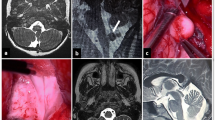Summary
A brain stem ganglioglioma in a 9-year-old female was examined ultrastructurally. The constituent neuronal (ganglion) cells displayed various ultrastructural features of neuronal degeneration including Hirano, Lafora and zebra bodies, inclusion-like aggregates of neurofilaments and large dilatations of rough endoplasmic reticulum. Although similar observations have been reported in peripheral neuronal tumors, this is the first reported occurrence in ganglioglioma, an uncommon tumor in the central nervous system. The coincidence of these alterations in the present tumor appeared to be of great interest, however, their exact etiology remained uncertain.
Similar content being viewed by others
References
Bender BL, Ghatak NR (1978) Light and electron microscopic observations on a ganglioneuroma. Acta Neuropathol (Berl) 42:7–10
Hirano A (1981) A guide to neuropathology, 1st edn. Igaku-Shoin, New York, pp 116–203
Hirano A, Tuazon R, Zimmerman HM (1968) Neurofibrillary changes, granulovacuolar bodies and argentophilic globules observed in tuberous sclerosis. Acta Neuropathol (Berl) 11:257–261
Johnson PC, Nielsen SL (1976) Localized neurofibrillary degeneration in vascular malformations. J Neuropathol Exp Neurol 35:300 (abstr.)
Kawai K, Takahashi H, Ikuta F, Tanimura K, Honda Y, Yamazaki H (1987) Occurrence of catecholamine neurons in a parietal lobe ganglioglioma. Cancer (in press)
Kudo M (1986) Hypothalamic gangliocytoma. Selective appearance of neurofibrillary changes, granulovacuolar degeneration, and argentophilic bodies. Acta Pathol Jpn 36:1225–1229
Lee JC, Glasauer FE (1968) Ganglioglioma: light and electron microscopic study. Neurochirurgia (Stuttg) 11:160–170
Liss L, Ebner K, Couri D (1979) Neurofibrillary tangles induced by a sclerosing angioma. Hum Pathol 10:104–108
Munoz-Garcia D, Ludwin SK (1984) Classic and generalized variants of Pick's disease: a clinicopathological, ultrastructural, and immunocytochemical comparative study. Ann Neurol 16:467–480
Norman MG (1974) Hyaline (“Colloid”) cytoplasmic inclusions in motoneurones in association with familial micrencephaly, retardation and seizures. J Neurol Sci 23: 63–70
Oberc-Greenwood MA, McKeever PE, Kornblith PL, Smith BH (1984) A human ganglioglioma containing paired helical filaments. Hum Pathol 15:834–838
Oyanagi S, Tanaka M, Omori T, Matsushita M, Ishii T (1979) Regular arrangements of tubular structures in Pick bodies formed in an autopsied case of Pick's disease. Shinkei Kenkyu no Shinpo 23:441–451
Powers JM, Balentine JD, Wisniewski HM, Terry RD (1976) Retroperitoneal ganglioneuroblastoma: a kaleidoscope of neuronal degeneration. A light and electron microscopic study. J Neuropathol Exp Neurol 35:14–25
Probst A, Ulrich J, Zdrojewski B, Hirt H-R (1979) Cerebellar ganglioglioma in a child. J Neuropathol Exp Neurol 38:57–71
Robitaille Y, Carpenter S, Karpati G, DiMauro S (1980) A distinct form of adult polyglucosan body disease with massive involvement of central and peripheral neuronal processes and astrocytes. A report of four cases and a review of the occurrence of polyglucosan bodies in other conditions such as Lafora's disease and normal ageing. Brain 103:315–336
Rubinstein LJ (1972) Tumor of the central nervous system. Atlas of tumor pathology, Series 2, Fascicle 6. Armed Forces Institute of Pathology, Washington, DC, pp 158–164
Rubinstein LJ, Herman MM (1972) A light and electron microscopic study of a temporal-lobe ganglioglioma. J Neurol Sci 16:27–48
Russel DS, Rubinstein LJ (1962) Ganglioglioma: a case with long history and malignant evolution. J Neuropathol Exp Neurol 21:185–193
Terry RD (1970) Electron microscopy of selected neurolipidoses. In: Vinken PJ, Bruyn GW (eds) Handbook of clinical neurology. North-Holland, Amsterdam, pp 362–384
VandenBerg SR, May EE, Rubinstein LJ, Herman MM, Perentes E, Vinores SA, Collins VP, Park TS (1987) Desmoplastic supratentorial neuroepithelial tumors of infancy with divergent differentiation potential (“desmoplastic infantile gangliogliomas”). Report on 11 cases of a distinctive embryonal tumor with favorable prognosis. J Neurosurg 66:58–71
Author information
Authors and Affiliations
Rights and permissions
About this article
Cite this article
Takahashi, H., Ikuta, F., Tsuchida, T. et al. Ultrastructural alterations of neuronal cells in a brain stem ganglioglioma. Acta Neuropathol 74, 307–312 (1987). https://doi.org/10.1007/BF00688197
Received:
Accepted:
Issue Date:
DOI: https://doi.org/10.1007/BF00688197




